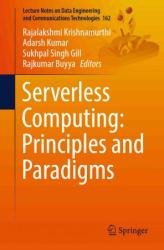Serverless Computing: Principles and Paradigms
- Добавил: literator
- Дата: 12-05-2023, 18:46
- Комментариев: 0
 Название: Serverless Computing: Principles and Paradigms
Название: Serverless Computing: Principles and ParadigmsАвтор: Rajalakshmi Krishnamurthi, Adarsh Kumar, Sukhpal Singh Gill
Издательство: Springer
Год: 2023
Страниц: 320
Язык: английский
Формат: pdf (true), epub
Размер: 22.8 MB
Serverless computing is a paradigm shift in cloud computing. Recently, many companies rely on serverless computing for their product application development and deployment, market analysis and customer relationship without investing excess on infrastructure development and maintenance. This book brought a single point of resource for researchers and practitioners on wide aspects of serverless technologies. The book presents serverless computing, data-centric serverless computing, distributed serverless computing and the road ahead and future of serverless computing. Further, it focuses on the fundamental of serverless computing such as the evolution of computing technologies, architecture, benefits, applications, issues and solutions in serverless computing, open challenges and future scope. Further, the book will present critical issues such as fine granularity and performance achievement in serverless computing. Next, the role of hyperscalers in serverless computing in terms of application development, business and economic perspective will be targeted.
This book explores how advances in graphic processing units (GPUs), programmable logic devices (TPUs), and field-programmable gate arrays have altered the serverless computing landscape (FPGAs). Distributed system architectures and implementations have undergone significant changes due to the popularity of serverless computing. Making and releasing product applications, doing market research, and maintaining customer interactions might all benefit from the reduced infrastructure expenses made possible by serverless computing. This book is a great resource for teachers and students interested in learning more about serverless computing. Some of the main questions surrounding serverless technology, such as scalability and performance distribution, are answered. Concepts and fundamentals of computing performance such as cost-free operation, good time and resource management, fairness, and interoperability are discussed. Serverless is at the forefront of this shift, which has made data-intensive, distributed applications, and open-source platforms essential for any modern computer to function. Data-centric queuing, real-time logging and monitoring, querying, and alarms are all examples of serverless services.
The key performance concepts such as no operational costs, scheduling and resource management, performance modelling, fairness, interoperability, virtualisation, data centres and portability are addressed. The merits of conventional serverless computing include autoscaling and pay-as-you-go mode. It lacks efficient data processing due to the shipping of data to the code, isolated VM for serverless functions, and non-addressable and limited internal cache state. However, modern computing in serverless requires data-intensive, distributed applications, open-source platforms and customisable hardware. The topics under serverless data lake architecture include functionalities such as data ingestion, data catalog, data discovery/searching, ETL and ELT methodologies in serverless data lake architecture. Next, the containers orchestration on containers such as Docker, Kubernetes, and Linux Containers will be addressed. The commercial data-centric serverless platforms frameworks such Amazon, Google, Azure and Oracle are covered. This book also discusses the need for hardware-level enhancement for data-centric serverless computing. For this purpose, the impact of multicore CPUs, cluster/grid computing, graphic processing units, tensor processing units and FPGA accelerators for serverless computing will be targeted. Further, the several big data format, storage and services mechanisms for serverless computing are presented. Here, the various modern data types and storage mechanisms such as spatial–temporal data, time series data, key-value data, and graph-based data storage, columnar data storage, real-time data streaming are addressed. The data-centric serverless services include interactive queuing, real-time logging and monitoring, querying, and notification services. Intensive data processing in serverless technology such as prediction, intelligent decision-making, real-time, big data analytics, and data science support for AI, ML and DL models in serverless computing is addressed.
Contents:
Скачать Serverless Computing: Principles and Paradigms
Внимание
Уважаемый посетитель, Вы зашли на сайт как незарегистрированный пользователь.
Мы рекомендуем Вам зарегистрироваться либо войти на сайт под своим именем.
Уважаемый посетитель, Вы зашли на сайт как незарегистрированный пользователь.
Мы рекомендуем Вам зарегистрироваться либо войти на сайт под своим именем.
Информация
Посетители, находящиеся в группе Гости, не могут оставлять комментарии к данной публикации.
Посетители, находящиеся в группе Гости, не могут оставлять комментарии к данной публикации.

